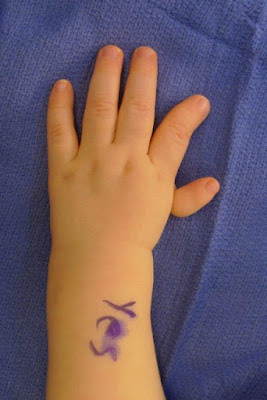Hello all. I want to share a good result in a challenging pollicization procedure. This patient has radial longitudinal deficiency with a poor, very limited thumb (we call it type 4 hypoplastic thumb). The decision was made to excise the thumb and create a new one with the index finger (e.g., the pollicization procedure). We know that this is a great procedure- I have blogged about this many times as you can see at this link: http://congenitalhand.wustl.edu/search?q=pollicization
We also know that there are a couple of factors that affect the results after the pollicization procedure. 1. The severity of the radial longitudinal deficiency. If highly severe and effecting the entire forearm- the results are likely to be worse.
2. The quality of the index finger. What we focus on is the motion- an index finger with good motion is likely to be a good thumb. An index finger with limited motion will provide a thumb which is not quite a good. Another factor is index finger alignment- when the index finger is crooked, it is likely to create a more limited thumb after pollicization. But, the alignment can be carefully adjusted to improve over time.
We have a great series of pictures to share. First, the pictures before surgery. Note the really small thumb (we call it a pouce floutant, or Type 4 small thumb). Also note how crooked the index finger is- this is clinodactyly and is very uncommon in this situation.
 |
| Hypoplastic thumb– note how small and deficient it is. Also see the deformity of the index finger. |
 |
| Hypoplastic thumb with index finger deformity. Patient is trying to make a fist and index finger does not bend well. This makes an excellent outcome after pollicization more difficult. |
We performed the pollicization procedure around 2 years of age. At the time, we also worked to straighten the new thumb by adjusting the growth plate. The scar is a bit different from usual because we had to address the thumb growth plate. See these pictures next.
 |
| After pollicization surgery. Note that there still is deformity in the thumb as this will correct over time and with growth. |
 |
| After pollicization surgery. Note that there still is deformity in the thumb as this will correct over time and with growth. |
 |
| After pollicization surgery. Note that there still is deformity in the thumb as this will correct over time and with growth. |
We then saw him at 6 weeks after surgery- note how well he was already using the thumb.
 |
| Pinching 6 weeks after pollicization surgery |
 |
| 6 weeks after pollicization surgery |
 |
| 6 weeks after pollicization surgery. There is still deformity but good alignment. |
 |
| 6 weeks after pollicization surgery. There is still deformity but good alignment. |
Here he is at 2 years after pollicization. Again, I am pleased with the result and he is using his head regularly.
 |
| 2 years after pollicization with excellent pinch. |
 |
| 2 years after pollicization at rest. |
 |
| 2 years after pollicization with improved deformity of the new thumb. |
Finally, here he is, 7 years after pollicization. Here is a video showing his function. He uses the thumb for everything. While he uses the other hand as first choice (he is right hand dominant), the left hand and the thumb work great for him.
It will great to watch as he continues to progress. This is an unusual pollicization but an excellent result despite different ‘challenges’.
Charles A. Goldfarb, MD
email: congenitalhand@wustl.edu
Please CLICK HERE to support our research.
Designate my name. Thank you!











